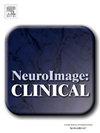基于大脑的视觉障碍中整合与分离网络的重组。
IF 3.4
2区 医学
Q2 NEUROIMAGING
引用次数: 0
摘要
越来越多的证据表明,大脑连通性会随着发育和环境经历而改变模块拓扑结构,从而改变其网络组织。然而,人们对与早期神经损伤导致的视觉障碍有关的大脑连通性变化仍不完全了解。脑性视力障碍(CVI)是一种基于大脑的视觉疾病,与视网膜后通路和视觉处理相关区域的损伤和发育不良有关。在这项研究中,我们采用多模态成像方法和基于结构(基于体素的形态测量;VBM)和静息状态功能连接(rsfc)的连接组学分析,研究了 CVI 患者与神经发育正常的对照组相比,在加权程度和连接水平上的差异。我们发现,与对照组相比,CVI 患者的初级视觉皮层和顶内沟(IPS)灰质体积明显减少。CVI 患者还表现出明显的重组特征,即视觉与躯体感觉和多模态整合区(背侧和腹侧注意力区)的整合增加,而视觉与边缘和默认模式网络的连接降低。CVI 的连接水平功能变化还与视觉功能和发育相关的主要临床结果有关。这些研究结果提供了早期洞察力,让我们了解与早期脑损伤相关的视觉损伤如何明显重组人脑的功能网络结构。本文章由计算机程序翻译,如有差异,请以英文原文为准。
Reorganization of integration and segregation networks in brain-based visual impairment
Growing evidence suggests that cerebral connectivity changes its network organization by altering modular topology in response to developmental and environmental experience. However, changes in cerebral connectivity associated with visual impairment due to early neurological injury are still not fully understood. Cerebral visual impairment (CVI) is a brain-based visual disorder associated with damage and maldevelopment of retrochiasmal pathways and areas implicated in visual processing. In this study, we used a multimodal imaging approach and connectomic analyses based on structural (voxel-based morphometry; VBM) and resting state functional connectivity (rsfc) to investigate differences in weighted degree and link-level connectivity in individuals with CVI compared to controls with neurotypical development. We found that participants with CVI showed significantly reduced grey matter volume within the primary visual cortex and intraparietal sulcus (IPS) compared to controls. Participants with CVI also exhibited marked reorganization characterized by increased integration of visual connectivity to somatosensory and multimodal integration areas (dorsal and ventral attention regions) and lower connectivity from visual to limbic and default mode networks. Link-level functional changes in CVI were also associated with key clinical outcomes related to visual function and development. These findings provide early insight into how visual impairment related to early brain injury distinctly reorganizes the functional network architecture of the human brain.
求助全文
通过发布文献求助,成功后即可免费获取论文全文。
去求助
来源期刊

Neuroimage-Clinical
NEUROIMAGING-
CiteScore
7.50
自引率
4.80%
发文量
368
审稿时长
52 days
期刊介绍:
NeuroImage: Clinical, a journal of diseases, disorders and syndromes involving the Nervous System, provides a vehicle for communicating important advances in the study of abnormal structure-function relationships of the human nervous system based on imaging.
The focus of NeuroImage: Clinical is on defining changes to the brain associated with primary neurologic and psychiatric diseases and disorders of the nervous system as well as behavioral syndromes and developmental conditions. The main criterion for judging papers is the extent of scientific advancement in the understanding of the pathophysiologic mechanisms of diseases and disorders, in identification of functional models that link clinical signs and symptoms with brain function and in the creation of image based tools applicable to a broad range of clinical needs including diagnosis, monitoring and tracking of illness, predicting therapeutic response and development of new treatments. Papers dealing with structure and function in animal models will also be considered if they reveal mechanisms that can be readily translated to human conditions.
 求助内容:
求助内容: 应助结果提醒方式:
应助结果提醒方式:


